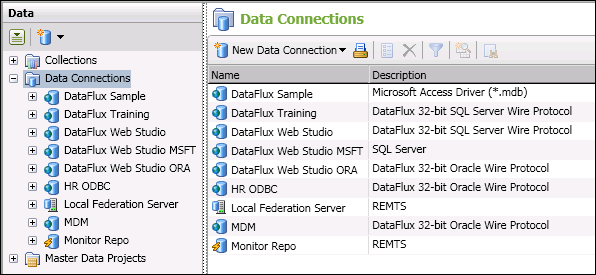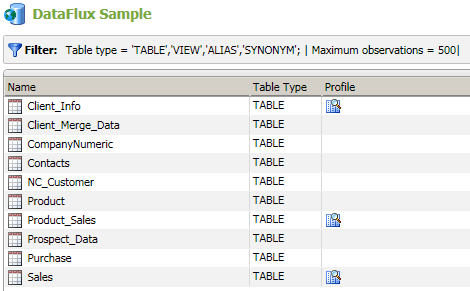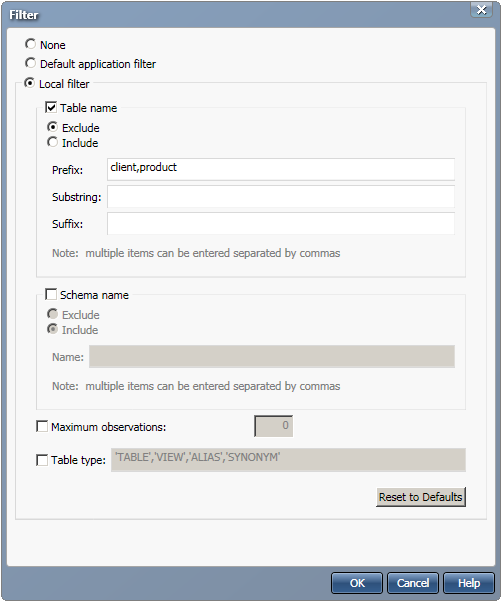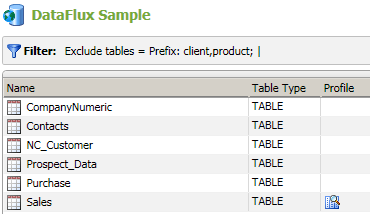Maintaining Data Connections for the Client
- Add a Data Connection for the Client
- Working with a Connection on the Client
- Filter a Data Connection on the Client
- Saving User Credentials for a Connection on the Client
- See also Data Connection Usage Notes
Add a Data Connection for the Client
To add a connection definition for DataFlux Data Management Studio, click the Data riser bar, and then select the Data Connections folder. The next figure shows an expanded the Data Connections folder on the left and the Data Connections pane on the right.

Click the down arrow in the New Data Connection control on the right and select the kind of connection that you want to add. See Connection Types for the Client for links to topics that describe how to add each connection type.
Working with a Connection on the Client
You can right-click a connection in the Data Connections pane to access a group of maintenance functions in a pop-up window. These functions are covered in the following table:
| Function | Description |
|---|---|
| Properties | Displays the dialog for the selected connection type. You can use the dialog to edit an existing connection. |
| Filter | Enables you to restrict the data that is available in a connection. See Filter a Data Connection. |
| Save/Clear Credentials | Enables you to save or clear authentication credentials for a selected data connection. See Saving User Credentials for a Connection. |
| Explore | Enables you to create a new data exploration. See Maintaining Data Explorations. |
| Find in Data | Displays the selected connection (or table) in the Data Connections folder in the Data riser bar. |
You can also click a connection to view a list of the tables that it contains. You can use the tools displayed above the table to perform the following functions:
- Create a query
- Create a data exploration
- Create a profile report
- Find the table in the Data Connections folder
![]() Note: If the connection to a server is broken, and then it is restored in the same DataFlux Data Management Studio session, you might need to clear the DSN connection cache. To do so, click Clear DSN Connection Cache in the Tools menu in the main menu to restore your connection.
Note: If the connection to a server is broken, and then it is restored in the same DataFlux Data Management Studio session, you might need to clear the DSN connection cache. To do so, click Clear DSN Connection Cache in the Tools menu in the main menu to restore your connection.
Filter a Data Connection on the Client
By filtering the data in a connection, you can analyze a set of records that share some attribute, execute a test job on a small subset of the data that is available in a connection, or perform similar tasks. You can use the Filter dialog to specify that the connection is unfiltered (None), processed by the default application filter (Default application filter), or processed by a local filter (Local filter). For example, you can perform the following steps to create a local filter:
- Double-click the data connection in the Data Connections pane to review its table and filter settings, as shown in the following display:

The data connection contains ten tables. The default application filter is applied. - Right-click the data connection in the Data tree and click Filter in the pop-up window. The Filter dialog is shown in the following display:

The local filter is enabled. Then, the prefixes client and product are excluded from the table names. Click OK to save the local filter. - Review the filtered data connection, as shown in the following display:

Note that only six tables remain in the filtered data connection. The filter settings are displayed in the Filter row.
Saving User Credentials for a Connection on the Client
If you specify a DSN connection in a data job or a process job, and no credentials have been saved to the connection, then the job will fail. The job will not prompt you to enter the missing credentials. This is appropriate because jobs are often executed in batch, so prompting for credentials would not work in that context. To use this DSN in a job, you would have to do one of the following, depending on the type of connection.
For Test Environments
If it is acceptable to save credentials for a data connection on the client, consider these connection types.
ODBC DSNs. You can specify credentials on several levels. You can save credentials in the ODBC Data Source Administrator window for this connection. Alternatively, you can right-click the connection in the Data Connections folder, select Save User Credentials, and then enter any credentials that are required to access data with that connection. If saving credentials to the ODBC connection is not acceptable, consider using a domain-enabled ODBC connection. Basically, you create a connection that references an ODBC connection and an appropriate Authentication Server domain. For more information, see Adding Domain Enabled ODBC Connections.
Connection credentials for the client are saved to the folder where all of the application-specific settings supplied by a user are stored. Here is an example path under Windows 7:
C:\Users\[username]\AppData\Roaming\SAS\dac\savedconn
You can use the DAC/SAVEDCONNUSER option to change the default location of saved connections. See the DataFlux Data Management Studio Installation and Configuration Guide for details about this option.
Custom DSNs. You can right-click the connection in the Data Connections folder, select Save User Credentials, and then enter any credentials that are required to access data with that connection.
For Production Environments
In a production environment, it might not be acceptable to save credentials for a data connection on the client. If so, consider these connection types.
SAS data set connections. No user credentials are required for a connection that is created with the SAS Data Set Connection dialog. The SAS data is accessed directly on disk without mediation by a server.
Domain-Enabled ODBC Connections. You can create a connection on the server that references an ODBC connection and an appropriate Authentication Server domain. For more information, see Adding Domain Enabled ODBC Connections.